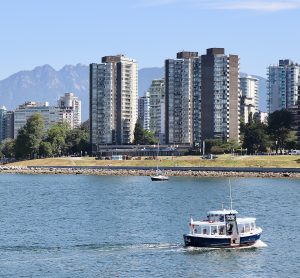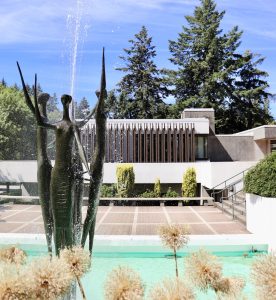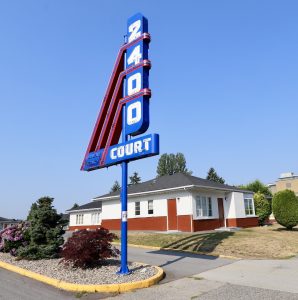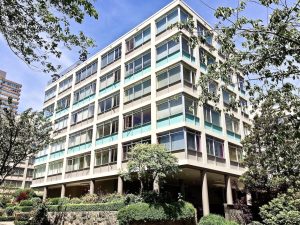
A Three Day Guide to Midcentury Vancouver
By Ken MacIntyre
(Vancouver, August 18, 2024) – When most people think of Vancouver, Canada, it’s for the mountains, the ocean and every outdoor activity under the sun. But for architourists more inclined to appreciate a built environment this West Coast city doesn’t disappoint especially when it comes to its midcentury modern heritage.

Mid-1960s modernist towers in the city’s West End
WEST COAST MODERN
When downtown, explore the recently reimagined General Post Office building originally designed by McCarter and Nairne. The city’s biggest midcentury modern structure was dubbed the “Taj Mahal with escalators” when it opened in 1958. Today “The Post” building stands as a unique example of adaptive re-use.
Adjacent to downtown is one of Canada’s most densely populated square kilometers, a peninsula known as the West End. Here you’ll find an abundance of 1950s and ‘60s midcentury residences from Brutalist towers to International Style apartments including the city’s first modernist residential high-rise; Ocean Towers (1958).
The University of British Columbia also boasts many architectural treasures including the Thea Koerner House graduate student centre (1961/1971), the Museum of Anthropology designed by Arthur Erickson (1976), and International House (1957) which helped to launch the campus as a world class modernist precinct.

The Thea Koerner House, built 1961/1971
Drive through Stanley Park, featuring the Brockton Point Lighthouse (1914), and across the Lions Gate Bridge (1938) to North and West Vancouver where old school post & beam homes are plentiful in the Capilano Highlands area. The Ambleside and Dundarave neighborhoods also hold some of the most striking apartment buildings in the city – midcentury or not – including the Villa Maris (1965) and the Shoreland Apartments (1963).
LET THERE BE LIGHT
In 1953, Vancouver had over 19,000 neon signs, more than any city on earth aside from Shanghai. Today, these shimmering remnants are scarce but you can still spot some in the wild. The 2400 Court motel sign on Kingsway used to beckon travelers from afar when it opened in 1946. It stands proudly as a reminder of when this early major thoroughfare was awash in neon. The Museum of Vancouver – located inside one of the city’s most unique modernist structures, the H.R. MacMillan Space Centre (1968) – holds a 1950s Gallery which boasts artifacts from Vancouver’s prosperous post-war years including several vintage neon signs. The city’s largest collection, though, will soon be seen at “The Post” building on Georgia. On loan from the Museum of Vancouver, 20 restored neon signs are scheduled to be displayed in various public spaces throughout the building in the coming year.

Vintage neon signage at the 2400 Court Motel
EAT + DRINK
For vintage dining, The Tomahawk is not to be missed. This busy North Vancouver restaurant with its diner-style lunch counter and assorted First Nations bric-a-brac has been doing business in the same location since 1960. The Templeton Diner on Granville Street is a vintage jukebox-lined eatery from 1950 serving up a healthy twist on greasy spoon fare. The Park Crest Diner is another time capsule of counter service and formica booths perfectly preserved from 1962, located on Broadway in the neighboring city of Burnaby. If you’re into Mai Tais and Tiki Bars, don’t miss The Shameful Tiki on eclectic Main Street. Although relatively new by most standards, it evokes 1950s & ‘60s Polynesian pop culture like nowhere else.
For additional midcentury modern recommendations around Vancouver, be sure to follow us on Instagram @modtraveler or on Facebook … as well, be sure to check out our extensive Vancouver location listings section here on the website!

A late 1950s midcentury low rise in Vancouver’s West End neighborhood
